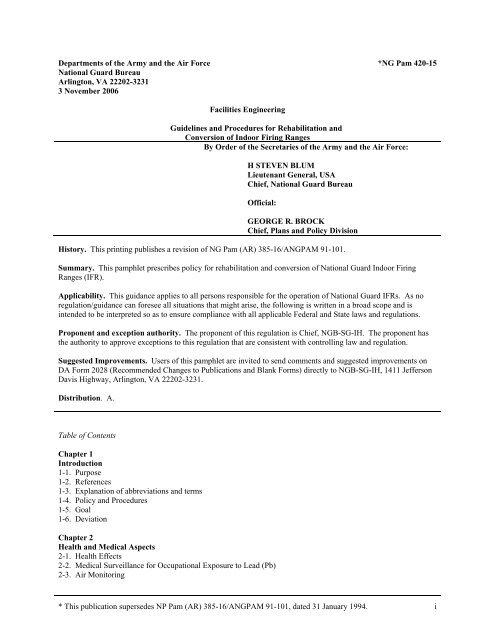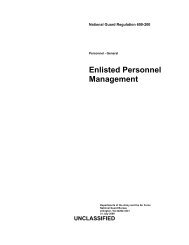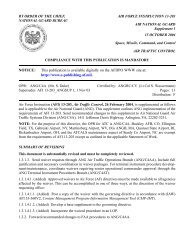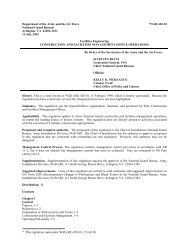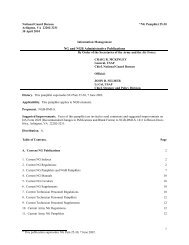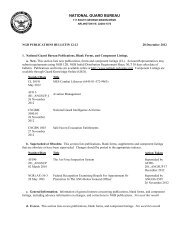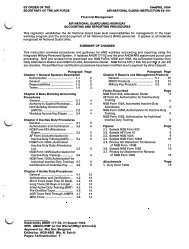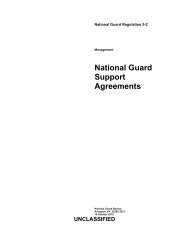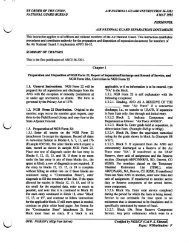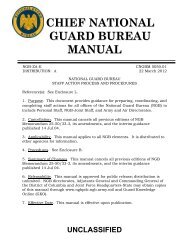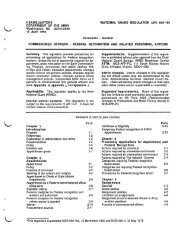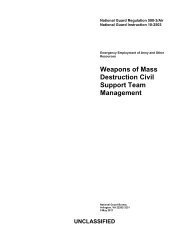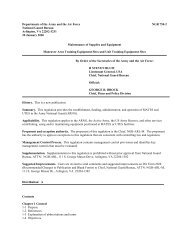NG Pam 420-15 - NGB Publications and Forms Library
NG Pam 420-15 - NGB Publications and Forms Library
NG Pam 420-15 - NGB Publications and Forms Library
- No tags were found...
You also want an ePaper? Increase the reach of your titles
YUMPU automatically turns print PDFs into web optimized ePapers that Google loves.
Departments of the Army <strong>and</strong> the Air Force *<strong>NG</strong> <strong>Pam</strong> <strong>420</strong>-<strong>15</strong>National Guard BureauArlington, VA 22202-32313 November 2006Facilities EngineeringGuidelines <strong>and</strong> Procedures for Rehabilitation <strong>and</strong>Conversion of Indoor Firing RangesBy Order of the Secretaries of the Army <strong>and</strong> the Air Force:H STEVEN BLUMLieutenant General, USAChief, National Guard BureauOfficial:GEORGE R. BROCKChief, Plans <strong>and</strong> Policy DivisionHistory. This printing publishes a revision of <strong>NG</strong> <strong>Pam</strong> (AR) 385-16/A<strong>NG</strong>PAM 91-101.Summary. This pamphlet prescribes policy for rehabilitation <strong>and</strong> conversion of National Guard Indoor FiringRanges (IFR).Applicability. This guidance applies to all persons responsible for the operation of National Guard IFRs. As noregulation/guidance can foresee all situations that might arise, the following is written in a broad scope <strong>and</strong> isintended to be interpreted so as to ensure compliance with all applicable Federal <strong>and</strong> State laws <strong>and</strong> regulations.Proponent <strong>and</strong> exception authority. The proponent of this regulation is Chief, <strong>NG</strong>B-SG-IH. The proponent hasthe authority to approve exceptions to this regulation that are consistent with controlling law <strong>and</strong> regulation.Suggested Improvements. Users of this pamphlet are invited to send comments <strong>and</strong> suggested improvements onDA Form 2028 (Recommended Changes to <strong>Publications</strong> <strong>and</strong> Blank <strong>Forms</strong>) directly to <strong>NG</strong>B-SG-IH, 1411 JeffersonDavis Highway, Arlington, VA 22202-3231.Distribution. A.Table of ContentsChapter 1Introduction1-1. Purpose1-2. References1-3. Explanation of abbreviations <strong>and</strong> terms1-4. Policy <strong>and</strong> Procedures1-5. Goal1-6. DeviationChapter 2Health <strong>and</strong> Medical Aspects2-1. Health Effects2-2. Medical Surveillance for Occupational Exposure to Lead (Pb)2-3. Air Monitoring* This publication supersedes NP <strong>Pam</strong> (AR) 385-16/A<strong>NG</strong>PAM 91-101, dated 31 January 1994. i
<strong>NG</strong>P <strong>420</strong>-<strong>15</strong> 3 November 20062-4. Wipe Sampling Protocol <strong>and</strong> Media2-5. Personal Protection EquipmentChapter 3Education, Maintenance, Cleaning <strong>and</strong> Conversion3-1. Worker Education3-2. Range Cleaning Instructions3-3. Cleaning Stored Contaminated Equipment3-4. Contaminated S<strong>and</strong> <strong>and</strong> Lead Waste3-5. Range Rehabilitation3-6. Conversion of Indoor Firing RangesAppendixesA. ReferencesB. Protocol for Collecting Wipe SamplesC. Sampling Strategy for Collection of Wipe SamplesGlossaryii
3 November 2006 <strong>NG</strong>P <strong>420</strong>-<strong>15</strong>1-1. PurposeThis pamphlet establishes the policy <strong>and</strong> procedures for rehabilitation <strong>and</strong> conversion, of National Guard IFRs.1-2. ReferencesRequired <strong>and</strong> related publications <strong>and</strong> referenced <strong>and</strong> prescribed forms are listed in Appendix A.1-3. Explanation of abbreviations <strong>and</strong> termsAbbreviations <strong>and</strong> special terms used in this publication are listed in the glossary.1-4. Policy <strong>and</strong> ProceduresIndoor firing ranges can be safely rehabilitated or converted for other uses, such as a storage area, classrooms oroffice space, provided the following –a. Prior to conversion active ranges must be thoroughly decontaminated <strong>and</strong> cleaned to acceptable levels. Allranges converted prior to the publication date of this pamphlet, must be inspected <strong>and</strong> evaluated to determine leadcontamination. This will be accomplished by a certified National Guard Industrial Hygienist (IH) or a personcertified to perform inspections, evaluations, <strong>and</strong> determinations of IFRs IAW with OSHA st<strong>and</strong>ards, othernationally accepted st<strong>and</strong>ards, <strong>and</strong> accepted IH practices for maintenance, cleaning, conversion, ventilation, <strong>and</strong> airsampling of IFRs.b. The level of cleanliness is to be determined by sampling. The Occupational Safety <strong>and</strong> HealthAdministration's (OSHA) Technical Manual, 5th Edition, provides guidance on the methods <strong>and</strong> techniques neededto collect wipe samples (Appendix B).(1) Wipe samples must be collected <strong>and</strong> analyzed prior to <strong>and</strong> after cleaning.(2) Post-cleaning surface wipe sample results must be less than 200 micrograms per square foot (ug/ft 2 )(40 micrograms in the case of child exposure). The sampling strategy, which is the amount <strong>and</strong> location of wipesamples to be collected, is provided in Appendix C.c. Equipment/Items previously stored in the range must be decontaminated <strong>and</strong> cleaned to acceptable levels asdetermined by a person certified to perform inspections, evaluations, <strong>and</strong> determinations of IFRs IAW with OSHAst<strong>and</strong>ards, other nationally accepted st<strong>and</strong>ards, <strong>and</strong> accepted IH practices for maintenance, cleaning, conversion,ventilation, <strong>and</strong> air sampling of IFRs.(1) Samples must be collected from equipment/items stored in the range. Sample selection is critical,because the number of items stored, length of storage, <strong>and</strong> level of contamination differs from range to range. Theamount <strong>and</strong> location of the samples should be representative of the areas where lead dust is most likely toaccumulate. The more samples collected, the better the statistical comparison of the results.(2) Samples must be collected from the smooth surfaces of the equipment/items, as much as possible.Results of samples collected from a rough surface will be inaccurate due to the minimal surface contact of themedia. Further, the likelihood of tearing the media filter is greater on rough surfaces.(3) Samples should also be collected on items stored the longest period of time, <strong>and</strong> which have not beendisturbed. Items stored closest to the bullet trap <strong>and</strong> firing line are likely to have higher concentrations of lead dust.1-5. GoalTo ensure that every IFR is free of lead dust which means to test less than 200 micrograms <strong>and</strong> to reduce the numberof unsafe National Guard IFRs.1-6. DeviationDeviations from this guidance will require a written exception to policy from your Regional Industrial HygieneOffice. Questions <strong>and</strong>/or comments regarding this subject should be directed to your Regional Industrial HygieneOffice or Chief, National Guard Bureau, Office of the Joint Surgeon, ATTN: <strong>NG</strong>B-SG-IH, 1411 Jefferson DavisHighway, Arlington, VA 22202-3231.Chapter 2Health <strong>and</strong> Medical Aspects2-1. Health Effects29 Code of Federal Regulations (CFR) 1910.1025, Appendix A, identifies lead as a highly toxic metal. Elementallead is indestructible, <strong>and</strong> common in the environment. Lead can enter the body by inhalation (breathing) or1
<strong>NG</strong>P <strong>420</strong>-<strong>15</strong> 3 November 2006ingestion (eating). In addition, lead is a cumulative poison. It accumulates in the blood, bones, <strong>and</strong> organs,including the kidneys, brain <strong>and</strong> liver. Effects include nervous <strong>and</strong> reproductive system disorders, delays inneurological <strong>and</strong> physical development, cognitive <strong>and</strong> behavioral changes, <strong>and</strong> hypertension. Symptoms includeloss of appetite, difficulty sleeping, irritability, fatigue, headache, <strong>and</strong> inability to concentrate. It can stay in thebones for decades. Worker awareness <strong>and</strong> training are important to ensure that employees can recognize thesymptoms of exposure <strong>and</strong> get prompt medical attention.2-2. Medical Surveillance for Occupational Exposure to Lead (Pb)a. Per 29 CFR 1910.1025 (j)(i-ii), Medical Surveillance - General, “The employer shall institute a medicalsurveillance program for all employees who are or may be exposed above the action level for more than 30 days peryear. The employer shall assure all medical examinations <strong>and</strong> procedures are performed by or under the supervisionof a licensed physician."b. The DOD 6055.5-M, Occupational Medical Surveillance Manual - Table 2-1 lists medical surveillancecriteria for employees “who are or may be exposed above the action level for 30 days/year.”2-3. Air MonitoringWorker breathing zone air samples must be collected to ensure that personnel are not overexposed to airborne leadduring the cleanup phase. Daily air samples will be collected from all personnel involved in the cleanup operation.These exposure levels will be used to evaluate work practices <strong>and</strong> medical surveillance requirements.2-4. Wipe Sampling Protocol <strong>and</strong> MediaA template measuring 10 centimeters by 10 centimeters square, approximately 4 inches square, should be used toaccurately measure <strong>and</strong> mark the area before collecting wipe samples. Samples should be staggered to differentareas of the range. A grid system should be utilized. Samples should not be collected all on one section of a wall, orend of the building. OSHA Technical Manual provides the necessary guidance on the technique needed to collectwipe samples (Appendix B). Only distilled or deionized water will be used to saturate dry sample media. At leastone field blank must be submitted with every 10 samples. The field blank must be from the same lot, <strong>and</strong> labeled asa blank.2-5. Personal Protective Equipment29 CFR 1910.1025 (f) (2), for housekeeping <strong>and</strong> rehabilitation the employer shall select respirators from amongthose approved for protection against dust, fume, <strong>and</strong> mist by the National Institute for Occupational Safety <strong>and</strong>Health (NIOSH), under the provision of 42 CFR part 84. The employer shall institute a respiratory protectionprogram in accordance with 29 CFR 1910.134 (b), (d), (e) <strong>and</strong> (f). As a minimum, personnel conducting thedecontamination of the range will be provided with the following personal protective equipment.a. Under 29 CFR 1910.1025 (g). For employees engaged in range rehabilitation <strong>and</strong>/or range conversion, theemployer shall provide at no cost to the employee, <strong>and</strong> ensure that the employee uses appropriate protective workclothing <strong>and</strong> equipment such as, but not limited to:(1) Protective coveralls with hood <strong>and</strong> shoe covers or disposable Tyvek full body suit.(2) Disposable rubber gloves; <strong>and</strong> disposable shoe coverlets (If necessary).(3) Full-face air purifying respirator with P-100 cartridges.b. The employer shall provide the clothing required in a clean <strong>and</strong> dry condition at least daily to employeesengaged in the conversion of IFRs.c. The employer shall provide for the cleaning, laundering, or disposal of used or contaminated protectiveclothing <strong>and</strong> equipment.d. The employer shall assure that all protective clothing is removed at the completion of a work shift only inareas designated for that purpose (Change Areas or Change Rooms).e. The employer will ensure that contaminated protective clothing that is to be cleaned, laundered, or disposedof, is placed in a closed container in the change area that seals sufficiently enough to prevent dispersion of lead dust.f. The employer will further inform in writing any person who cleans or launders protective clothing orequipment of the potentially harmful effects of exposure to lead.g. The employer will ensure that the containers of contaminated protective clothing <strong>and</strong> equipment are labeledas follows: CAUTION: CLOTHI<strong>NG</strong> CONTAMINATED WITH LEAD. DO NOT REMOVE DUST BY BLOWI<strong>NG</strong>OR SHAKI<strong>NG</strong>. DISPOSE OF LEAD CONTAMINATED WASH WATER IN ACCORDANCE WITH APPLICABLELOCAL, STATE, OR FEDERAL REGULATIONS.2
3 November 2006 <strong>NG</strong>P <strong>420</strong>-<strong>15</strong>Chapter 3Education, Maintenance, Cleaning <strong>and</strong> Conversion3-1. Worker Educationa. 29 CFR 1910.1025, Appendix B, requires an information <strong>and</strong> training program for all employees exposed tolead above the action level or who may suffer skin or eye irritation from lead. The program must inform theemployees of the specific hazards associated with their work environment, protective measures which can be taken,the danger of lead to their bodies (including their reproductive systems), <strong>and</strong> their rights under the st<strong>and</strong>ard. Inaddition you must make readily available to all employees, including those exposed below the action level, a copy ofthis st<strong>and</strong>ard <strong>and</strong> its appendices. This training program will be repeated annually for personnel in range cleanupoperations.b. The comm<strong>and</strong>er/supervisor will ensure that each soldier or Army National Guard (AR<strong>NG</strong>) employee isinformed of the following:(1) The content of the st<strong>and</strong>ard <strong>and</strong> its appendices.(2) The specific nature of operations that could result in exposure to lead above the action level.(3) The purpose, proper selection, fitting, use <strong>and</strong> limitations of respirators.(4) The purpose <strong>and</strong> a description of medical surveillance program.(5) Eating <strong>and</strong> drinking are prohibited in lead contaminated areas.(6) Smoking <strong>and</strong> smoking materials will not be permitted in contaminated areas.(7) Soldiers <strong>and</strong> AR<strong>NG</strong> employees must wash their h<strong>and</strong>s <strong>and</strong> other exposed skin whenever they leavethe work area.(8) The engineering controls <strong>and</strong> work practices associated with the individual’s job assignment.(9) The contents of any compliance plan in effect.(10) Instructions to soldiers <strong>and</strong> AR<strong>NG</strong> employees that chelating agents should not routinely be used toremove lead from their bodies <strong>and</strong> should not be used at all except under the direction of a licensed physician.3-2. Range Cleaning Instructionsa. Written procedures, such as a scope of work, or st<strong>and</strong>ing operating procedure that complies with all Federal,State <strong>and</strong> local regulations must be established prior to decontamination operations.b. The range ventilation system will be in operation during range cleaning to ensure that a negative pressureenvironment is maintained. In the absence of mechanical ventilation system, all doors <strong>and</strong> windows will be sealedto eliminate fugitive emissions.c. A High Efficiency Particulate Air (HEPA) filtered vacuum system, which is designed to collect loosesurface lead dust particles, is the preferred method of cleanup. If a HEPA filtered vacuum is not available, the rangecan be cleaned using a wet method.d. Prohibited methods include:(1) Wet cleaning using high-pressure systems, since this method may embed the lead into the substratum<strong>and</strong> generate large quantities of hazardous waste.(2) Dry sweeping is not permitted.e. All surface areas of the range must be cleaned. In addition, areas outside of the IFR where lead can betracked must be cleaned.f. The preferred progression of cleaning is from top to bottom <strong>and</strong> from behind the steel bullet trap to thefiring line.(1) Clean the steel bullet trap, areas in front of <strong>and</strong> behind the bullet trap, <strong>and</strong> the steel bullet trapplate(s), after removing the s<strong>and</strong> (if applicable).(2) Clean the ceiling, floors, lights, baffles, retrieval system, heating system(s), <strong>and</strong> ventilation duct(s).(3) Vacuum <strong>and</strong> remove acoustical material. Painting over this material is not recommended.(4) Clean the floor the last, starting at the bullet trap <strong>and</strong> ending behind the firing line.g. When using a HEPA filtered vacuum, vacuum all surface areas until no dust or residue is visible.h. Any general purpose cleaning solutions can be used for the wet method. However, Spic <strong>and</strong> Span hasbeen found to be an effective cleaning solution by other Army organizations. Mix new solutions of cleaningsolution frequently. Wet wiping will require dual containers of water; one container for wetting the applicator(mops, rags, sponge, etc.) <strong>and</strong> the other container for rinsing the applicator after the dust has been wiped from thesurfaces. After wet wiping all surfaces, permit the area to dry.3
<strong>NG</strong>P <strong>420</strong>-<strong>15</strong> 3 November 2006i. Properly dispose of all hazardous waste. Do not place lead contaminated waste into the sewer system oronto the ground.(1) When placed in containers, wastewater should be left to evaporate.(2) Mop-heads, sponges <strong>and</strong> rags will be discarded as hazardous waste following cleanup.j. A thorough visual inspection to detect dust should be made following cleanup <strong>and</strong> prior to collecting postsurface wipe samples.k. Wood floors should receive a coat of deck enamel or urethane; concrete floors should be sealed with deckenamel.l. As a variety of conditions exist in ranges, unique situation may arise <strong>and</strong> specific written guidance fromyour Regional Industrial Hygiene Office may be required.m. Any cleaning activities must be under the supervision by a trained <strong>and</strong> competent personnel IAW withOSHA <strong>and</strong> other nationally accepted st<strong>and</strong>ards <strong>and</strong> the work shall be according to current industry engineeringst<strong>and</strong>ards under the control of the State Construction <strong>and</strong> Facilities Management Officer. Cleaning must recognizethat there likely will be “background” lead presence in the readiness center totally independent of the existence of anindoor range <strong>and</strong> that the method of cleaning is less important than achieving the goal of less than 200 micrograms(40 micrograms in the case of child exposure).3-3. Cleaning Stored Contaminated Equipmenta. Equipment contaminated (sample result is higher than 200 ug/ft 2 ) with lead dust must be decontaminatedbefore it is removed from the range.b. Equipment located near the bullet trap <strong>and</strong> firing line should be cleaned first <strong>and</strong> then removed. Thecleaning method depends on the size of the equipment <strong>and</strong> the material it is comprised of, i.e. metal, wood, concrete,porous, non-porous, smooth or rough finish etc. However, either HEPA vacuum or the wet wipe method will beused. Refer to paragraph 3-2 for additional guidance.c. Every attempt should be made to clean <strong>and</strong> reclaim items since disposing of equipment, as hazardous wasteis costly <strong>and</strong> wasteful. Only as a last resort will the item be discarded as hazardous waste. Porous items, such asoffice partitions <strong>and</strong> carpet that were present during firing should be considered grossly contaminated <strong>and</strong> bediscarded unless analysis proves otherwise. Consult your State Environmental Office for the proper hazardouswaste disposal methods.3-4. Contaminated S<strong>and</strong> <strong>and</strong> Lead WasteConsult your State Environmental Office for specific disposal guidance to ensure compliance with local laws <strong>and</strong>regulations.3-5. Range RehabilitationThis chapter applies to all IFRs that have been identified as c<strong>and</strong>idates for rehabilitation. It provides furtherguidance for cleaning <strong>and</strong>/or sampling that might be required prior to the start of rehabilitation.a. The portion(s) of the range to under go rehabilitation must be sampled to determine the level of leadcontamination. Wipe samples will be taken per the established sampling protocol. See Appendix B.b. All personnel involved in range rehabilitation will wear a NIOSH approved respirator (P-100) <strong>and</strong> properpersonal protective equipment as prescribed in paragraph 2-5 above.c. Prior to the start of rehabilitation, the environmental office must be notified to determine the disposition ofany debris containing hazardous materials (lead).d. Supervision shall be by a person who is certified to perform inspections, evaluations, <strong>and</strong> determinations ofIFRs IAW with OSHA st<strong>and</strong>ards, other nationally accepted st<strong>and</strong>ards, <strong>and</strong> accepted IH practices for maintenance,cleaning, conversion, ventilation, <strong>and</strong> air sampling of IFRs. All work shall be according to current industryengineering st<strong>and</strong>ards under the control of the State Construction <strong>and</strong> Facilities Management Officer.3-6. Conversion of Indoor Firing RangesPrior to the start of decontamination, employers must ensure that all procedures to be used comply with Federal,State, <strong>and</strong> local regulations. To ensure that all lead contamination is eradicated, the following procedure isestablished.a. The State shall follow the project approval process as delineated in <strong>NG</strong>R <strong>420</strong>-10 (or <strong>NG</strong>R 4<strong>15</strong>-5 if the useof the military construction appropriation is required).b. All ranges slated for conversion will be inspected <strong>and</strong> evaluated by the <strong>NG</strong>B Regional Industrial HygieneOffice.4
3 November 2006 <strong>NG</strong>P <strong>420</strong>-<strong>15</strong>c. All equipment stored in the range, if applicable, prior to the start of decontamination must be sampled,decontaminated, re-sampled <strong>and</strong> removed or turned in as lead contaminated material.d. All acoustical tiles <strong>and</strong>/or sound proofing material (if applicable) must be removed <strong>and</strong> turned in as leadcontaminated material through the environmental office.e. The bullet trap, target retrieval system <strong>and</strong> firing line stations must be removed <strong>and</strong> turned in as leadcontaining material through the environmental office.f. Light fixtures <strong>and</strong> ventilation system grills must be removed <strong>and</strong> decontaminated.g. Ventilation system ducts need to be decontaminated or removed <strong>and</strong> replaced.h. The exhaust fans <strong>and</strong>/or the complete ventilation air-h<strong>and</strong>ling unit (if applicable) must be decontaminated orremoved to include roof fans.i. Cover all openings of any component previously decontaminated prior to start of interior decontamination ofthe firing range.j. Prior to start of washing, the interior of the range should be vacuumed with a HEPA filtered vacuum. Therange should be washed using a cleaning solution of hot water <strong>and</strong> Spic <strong>and</strong> Span in five gallons of hot water. Aprogression of cleaning from top to bottom, <strong>and</strong> from back to front should be used. All surface areas of the rangemust be cleaned. Mix new solutions of water frequently. Washing will require dual containers of water; onecontainer for wetting the applicators (mops, rags, sponges, etc.), <strong>and</strong> the other container for rinsing the applicators.Waste water placed into containers can be left to evaporate. Properly dispose of all hazardous waste <strong>and</strong> do notplace any lead contaminated waste into the sewer system or onto the ground. Mop heads, sponges <strong>and</strong> rags will bediscarded as hazardous waste following decontamination of the range. After completion of decontamination, <strong>and</strong>prior to taking clearance samples, the ventilation system must be run for a period of 36 hours. Wipe clearancesamples will be taken from ceiling, walls <strong>and</strong> floors. The range will be considered clean if no clearance sample isgreater than 200 ug/ft 2 , if any sample is above 200 ug/ft 2 , the range is not considered clean, the range will need to bere-washed until clearance samples are below 200 ug/ft 2 .k. The regional industrial hygienist will do quality assurance sampling as needed.l After obtaining clearance, the walls of the range will be coated with a sealant (Not Paint), which is smooth,wood floors will receive a coat of deck enamel or urethane, concrete floors will be sealed with deck enamel. Aftersealing, floors will be tiled or covered with linoleum.m. As a variety of conditions exist in ranges, unique situations may arise <strong>and</strong> specific written guidance fromthe Regional Industrial Hygiene Office may be required.n. All personnel involved in the decontamination/conversion of IFRs as a minimum will be provided with thefollowing personal protective equipment.(1). Full Face air purifying respirator with HEPA cartridges. The requirements outline in 29 CFR1910.134, must be met prior to placing workers in respiratory protection.(2). Individuals will be provided personal protective equipment as required per paragraph 2-5, thispamphlet.o. Any conversion must be supervised by a person certified to perform inspections, evaluations, <strong>and</strong>determinations of IFRs IAW with OSHA st<strong>and</strong>ards, other nationally accepted st<strong>and</strong>ards, <strong>and</strong> accepted IH practicesfor maintenance, cleaning, conversion, ventilation, <strong>and</strong> air sampling of IFRs. All work shall be according to currentindustry engineering st<strong>and</strong>ards under the control of the State Construction <strong>and</strong> Facilities Management Officer.Cleaning must recognize that there likely will be “background” lead presence in the readiness center totallyindependent of the existence of an indoor range <strong>and</strong> that the method of cleaning is less important than achieving thegoal of less than 200 micrograms (40 micrograms in the case of child exposure).p. After conversion, lead testing shall continue on an annual basis to verify that no lead migration from thesubstrate is occurring.5
<strong>NG</strong>P <strong>420</strong>-<strong>15</strong> 3 November 2006Appendix AReferencesSection IRequired <strong>Publications</strong>There are no entries in this sectionSection IIRelated <strong>Publications</strong>ASTM E1792-03St<strong>and</strong>ard Specification for Wipe Sampling Materials for Lead in Surface DustAR 11-34The Respiratory Protection ProgramAR 40-5Preventive MedicineDODI 6055.5Industrial Hygiene <strong>and</strong> Occupational HealthDOD 6055.5-MOccupational Medical Surveillance Manual29 CFR, Part 1910Occupational Safety <strong>and</strong> Health Administration, Department of LaborNational Institute for Occupational Safety <strong>and</strong> Health (NIOSH) 76-130Lead Exposure <strong>and</strong> Design Considerations for Indoor Firing Ranges, Department of Health, Education <strong>and</strong> Welfare<strong>NG</strong>R 385-<strong>15</strong>Policy <strong>and</strong> Responsibilities for Inspection, Evaluation <strong>and</strong> Operation Army National Guard National Guard IndoorFiring Ranges (IFRs).<strong>NG</strong>R 4<strong>15</strong>-5Army National Guard Military Construction Program Development <strong>and</strong> Execution<strong>NG</strong>R <strong>420</strong>-10Construction <strong>and</strong> Facilities Management Office OperationsTechnical Manual, 5 th EditionOccupational Safety <strong>and</strong> Health Administration, Department of LaborSection IIIPrescribed <strong>Forms</strong>There are no entries in this section6
3 November 2006 <strong>NG</strong>P <strong>420</strong>-<strong>15</strong>Section IVReferenced <strong>Forms</strong>There are no entries in this sectionAppendix BProtocol for Collecting Wipe SamplesB-1. If multiple samples are to be collected at the work site, prepare a rough sketch of the area(s) or room(s), whichare to be wipe sampled.B-2. A new set of clean, impervious gloves should be used for each sample to avoid contamination of the media byprevious samples <strong>and</strong> to prevent contact with the substance.B-3. Wipe Samplesa. If using Ghost Wipes, tear open the individually sealed package. Remove the moistened wipe. Unfoldthe wipe.b. If using a dry media such as MCE or Whatman filter, moisten the filter with distilled or deionized waterprior to sampling.B-4. Place a 10 centimeter by 10 centimeter template on the area to be wiped.B-5. Apply uniform firm pressure while wiping the area inside the template.B-6. To ensure that all portions of the partitioned area are wiped, start at the outside edge <strong>and</strong> progress toward thecenter making concentric squares decreasing in size.B-7. After collecting a sample, fold the filter or wipe inward <strong>and</strong> place into a container <strong>and</strong> number it. Note thenumber at the sample location on the sketch.B-8. At least one blank filter treated in the same fashion but without wiping, should be submitted to the laboratory.Appendix CSampling Strategy for Collection of Wipe SamplesC-1. Prior to cleaning the ranges, three samples must be collected <strong>and</strong> analyzed for total lead dust on each surface,i.e., floor, ceiling, bullet trap, <strong>and</strong> wall to include the plenum wall, if applicable. In addition, a total of three samplesshould be collected from areas which have been least disturbed by airflow. Established walkways should beavoided.C-2. Samples should be collected from different areas of the range. A grid system should be utilized. Each rangesurface areas should be divided evenly into 3 by 3 sections. Samples should not be collected from only one sectionof a wall or end of the building.7
<strong>NG</strong>P <strong>420</strong>-<strong>15</strong> 3 November 2006GlossarySection IAbbreviationsAR<strong>NG</strong>Army National GuardCFRCode of Federal RegulationsHEPAHigh Efficiency Particulate AirIFRIndoor Firing RangeNIOSHNational Institute for Occupational Safety <strong>and</strong> HealthOSHAOccupational Safety <strong>and</strong> Health Administrationug/ft 2Micrograms per square footSection IITermsAir monitoringThe sampling for <strong>and</strong> measuring of pollutants in the atmosphere.Breathing zoneThe imaginary globe of two feet radius surrounding the head.General areaCollection of <strong>and</strong> later analysis of airborne contaminants in a given work environment. As the sampling pump <strong>and</strong>collection media are not attached to a worker, the concentrations found represent average concentrations in that areabut may not representative of the actual exposure of the worker.HEPARefers to high efficiency particulate air filter systems capable of capturing up to 99.97 percent of particles 0.3microns in size or larger.Lead-Contaminated RangeIt is assumed that all IFRs, which have been fired in, are lead-contaminated.RespiratorA device designed to provide the wearer with respiratory protection against inhalation of airborne contaminants.Wipe SampleThe terms wipe, swipe, or smear samples are used synonymously to describe the techniques utilized for assessinglead surface contamination.8
3 November 2006 <strong>NG</strong>P <strong>420</strong>-<strong>15</strong>Section IIISpecial Abbreviations <strong>and</strong> TermsThis section contains no entries9


